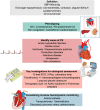Management of cardiogenic shock: a narrative review
- PMID: 38553663
- PMCID: PMC10980676
- DOI: 10.1186/s13613-024-01260-y
Management of cardiogenic shock: a narrative review
Abstract
Cardiogenic shock (CS) is characterized by low cardiac output and sustained tissue hypoperfusion that may result in end-organ dysfunction and death. CS is associated with high short-term mortality, and its management remains challenging despite recent advances in therapeutic options. Timely diagnosis and multidisciplinary team-based management have demonstrated favourable effects on outcomes. We aimed to review evidence-based practices for managing patients with ischemic and non-ischemic CS, detailing the multi-organ supports needed in this critically ill patient population.
Keywords: Cardiogenic shock; ECMO; Hemodynamic monitoring; Mechanical ventilation; Myocardial infarction; Shock.
© 2024. The Author(s).
Conflict of interest statement
Manzo-Silberman S has received consulting fees from Bayer, Organon, Exeltis, lecture fees from Bayer, BMS, Exeltis and Organon, has served in the adjudication board for a study for Biotronik. Hamzaoui O has received lecture fees from BAXTER. Laghlam D, Benghanem S, Ortuno S Bouabdallaoui N and Aissaoui N have no competing interests to declare.
Figures



Similar articles
-
Review of Advancements in Managing Cardiogenic Shock: From Emergency Care Protocols to Long-Term Therapeutic Strategies.J Clin Med. 2024 Aug 16;13(16):4841. doi: 10.3390/jcm13164841. J Clin Med. 2024. PMID: 39200983 Free PMC article. Review.
-
Mechanical Circulatory Support in Cardiogenic Shock: A Narrative Review.Cureus. 2024 Sep 13;16(9):e69379. doi: 10.7759/cureus.69379. eCollection 2024 Sep. Cureus. 2024. PMID: 39411633 Free PMC article. Review.
-
The Management of Cardiogenic Shock From Diagnosis to Devices: A Narrative Review.CHEST Crit Care. 2024 Jun;2(2):100071. doi: 10.1016/j.chstcc.2024.100071. Epub 2024 Apr 16. CHEST Crit Care. 2024. PMID: 38993934 Free PMC article.
-
Devices for mechanical circulatory support and strategies for their management in cardiogenic shock.Kardiol Pol. 2019 Jun 25;77(6):589-595. doi: 10.33963/KP.14831. Epub 2019 May 16. Kardiol Pol. 2019. PMID: 31095122 Review.
-
A Targeted Management Approach to Cardiogenic Shock.Crit Care Clin. 2018 Jul;34(3):423-437. doi: 10.1016/j.ccc.2018.03.009. Crit Care Clin. 2018. PMID: 29907274 Review.
Cited by
-
Review of Advancements in Managing Cardiogenic Shock: From Emergency Care Protocols to Long-Term Therapeutic Strategies.J Clin Med. 2024 Aug 16;13(16):4841. doi: 10.3390/jcm13164841. J Clin Med. 2024. PMID: 39200983 Free PMC article. Review.
-
Biomarkers in cardiogenic shock: old pals, new friends.Ann Intensive Care. 2024 Oct 16;14(1):157. doi: 10.1186/s13613-024-01388-x. Ann Intensive Care. 2024. PMID: 39414666 Free PMC article. Review.
-
Concurrent intra-aortic balloon pump and veno-arterial extracorporeal membrane oxygenation for acute coronary syndrome-related cardiogenic shock: A meta-analysis of multivariate studies.Biomol Biomed. 2025 Apr 26;25(6):1233-1244. doi: 10.17305/bb.2024.11011. Biomol Biomed. 2025. PMID: 39468905 Free PMC article.
-
Transcatheter Structural Heart Interventions in the Acute Setting: An Emerging Indication.J Clin Med. 2024 Jun 16;13(12):3528. doi: 10.3390/jcm13123528. J Clin Med. 2024. PMID: 38930057 Free PMC article. Review.
-
Mortality trends related to cardiogenic shock in heart failure patients aged 25 and older across the United States: A study utilizing the CDC WONDER database from 1999 to 2023.Int J Cardiol Heart Vasc. 2025 Jun 26;59:101732. doi: 10.1016/j.ijcha.2025.101732. eCollection 2025 Aug. Int J Cardiol Heart Vasc. 2025. PMID: 40678121 Free PMC article.
References
-
- Aissaoui N, Puymirat E, Delmas C, Ortuno S, Durand E, Bataille V, et al. Trends in cardiogenic shock complicating acute myocardial infarction. Eur J Heart Fail. 2020;22(4):664–672. - PubMed
-
- Arrigo M, Price S, Baran DA, Pöss J, Aissaoui N, Bayes-Genis A, et al. Optimising clinical trials in acute myocardial infarction complicated by cardiogenic shock: a statement from the 2020 Critical Care Clinical Trialists Workshop. Lancet Respir Med. 2021;9(10):1192–1202. - PubMed
-
- Baran DA, Grines CL, Bailey S, Burkhoff D, Hall SA, Henry TD, et al. SCAI clinical expert consensus statement on the classification of cardiogenic shock: This document was endorsed by the American College of Cardiology (ACC), the American Heart Association (AHA), the Society of Critical Care Medicine (SCCM), and the Society of Thoracic Surgeons (STS) in April 2019. Catheter Cardiovasc Interv. 2019;94(1):29–37. - PubMed
-
- Jentzer JC, van Diepen S, Barsness GW, Henry TD, Menon V, Rihal CS, et al. Cardiogenic shock classification to predict mortality in the cardiac intensive care unit. J Am Coll Cardiol. 2019;74(17):2117–2128. - PubMed
-
- van Diepen S, Katz JN, Albert NM, Henry TD, Jacobs AK, Kapur NK, et al. Contemporary management of cardiogenic shock: a scientific statement from the American heart association. Circulation. 2017;136(16):e232–e268. - PubMed
Publication types
LinkOut - more resources
Full Text Sources

